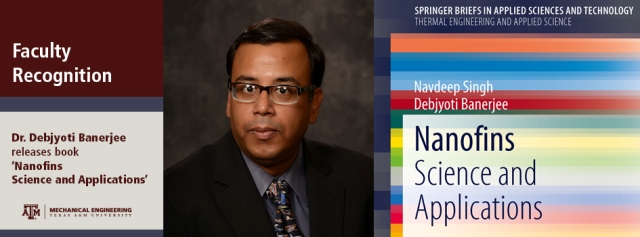Nov 25 2013
"Nanofins - Science and Applications”, a book co-authored by Dr. Debjyoti Banerjee with Dr. Navdeep Singh was recently published by Springer. Dr. Banerjee is an Associate Professor at the Department of Mechanical Engineering at Texas A&M University, and Dr. Navdeep Singh is one of his former Ph.D. students. Dr. Singh is currently a faculty member at the University of Houston.

The book covers the latest trends in the applications of nanotechnology to thermal-fluids. The authors coined the term “nanofin effect” to resolve the conundrums observed during enhancement of heat transfer and thermal energy storage that occurs in presence of nanoparticles. This occurs due to a combination of surface area enhancement and liquid-solid interactions at the molecular scale, as quantum effects kick-in. The applications of the “nanofin effect” in thermal management are explored in this book, such as for enhancing cooling/ thermal management, energy storage (thermal battery), energy efficiency (boiling and condensation in refrigeration/ air-conditioning), and energy harvesting (concentrated solar power, nuclear, geothermal, etc.). Molecular simulations for heat/ mass transfer were presented in the book to resolve the observed conundrums. The book recommends strategies for effectively leveraging nanotechnology for enhancing thermal management and energy storage.
Nanotechnology applications in thermal-fluids sciences and engineering have attracted significant attention for their promise to obviate bottlenecks due to increased appetite for cooling in emerging technologies. Effective energy storage technologies are needed as stable-nonrenewable power sources (coal, nuclear, etc.) and intermittent-renewable power sources (solar, geothermal, etc.) are progressively integrated into a smart grid. In pioneering studies led by Dr. Banerjee since 2005, cooling was enhanced significantly by surface nano-texturing. It was observed that surface nanostructures with lower thermal conductivity resulted in higher levels of boiling heat transfer. Going against conventional wisdom in pioneering studies since 2006, Dr. Banerjee’s research group demonstrated that nanoparticles and additives significantly enhanced the specific heat capacity of solvents (nanofluids). The physical phenomena responsible for enhanced transport of mass and storage of energy in the vicinity of the nanoparticles is termed as the “nanofin effect”. “Nanofins: Science and Applications” delves into the genesis and applications of this “nanofin effect”.
To learn more about Dr. Banerjee's work, please visit: http://db.tamu.edu/